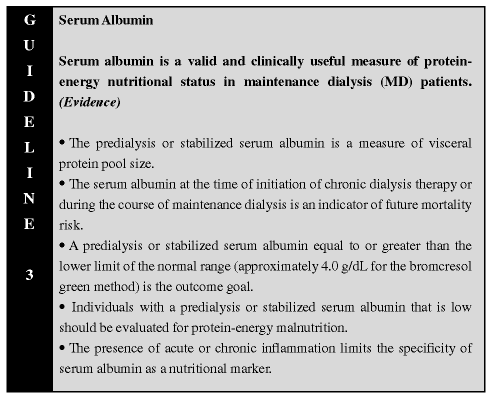
1. Evaluation of Protein-Energy Nutritional Status

Serum albumin levels have been used extensively to assess the nutritional status of individuals with and without chronic renal failure (CRF).17 Malnutrition is common in the end-stage renal disease (ESRD) population,18 and hypoalbuminemia is highly predictive of future mortality risk when present at the time of initiation of chronic dialysis as well as during the course of maintenance dialysis (MD).14,19-27 It follows that nutritional interventions that maintain or increase serum albumin concentrations may be associated with improved long-term survival, although this has not been proven in randomized, prospective clinical trials. Serum albumin levels may fall modestly with a sustained decrease in dietary protein and energy intake and may rise with increased protein or energy intake.28 Conversely, serum albumin levels may fall acutely with inflammation or acute or chronic stress and increase following resolution or recovery.
Despite their clinical utility, serum protein (eg, albumin, transferrin, and prealbumin) levels may be insensitive to changes in nutritional status, do not necessarily correlate with changes in other nutritional parameters, and can be influenced by non-nutritional factors.29-32 Some of these non-nutritional factors, which are frequently present in this population, include infection or inflammation, hydration status, peritoneal or urinary albumin losses, and acidemia.33-36 Hence, hypoalbuminemia in MD patients does not necessarily indicate protein-energy malnutrition (PEM). The patient's clinical status (eg, comorbid conditions, dialysis modality, acid-base status, degree of proteinuria) must be examined when evaluating changes in the serum albumin level. Serum albumin concentrations are inversely correlated with serum levels of positive acute-phase proteins.33,34,37 An elevated C-reactive protein has been reported to negate the positive relationship between serum albumin and nPNA.34 However, some studies suggest that serum albumin is independently affected by both inflammation and nutritional intake.34
As indicated above, positive acute-phase proteins (eg, C-reactive protein [CRP], alpha-1 acid glycoprotein [a1-AG], ferritin, and ceruloplasmin) are not nutritional parameters but may be used to identify the presence of inflammation38 in individuals with low serum albumin or prealbumin (Guideline 4) levels and possibly for predicting outcome. α1-AG may be more specific than CRP for detecting inflammation in MD patients.37 Serial monitoring of serum concentrations of positive acute-phase proteins (CRP, α1-AG) during episodes of inflammation in MD patients indicate that serum levels follow patterns similar to those found in acutely ill individuals who do not have CRF.39
Although no single ideal measure of nutritional status exists, the serum albumin concentration is considered to be a useful indicator of protein-energy nutritional status in MD patients. The extensive literature, in individuals with orwithout renal failure, relating serum albumin to nutritional status, and the powerful association between hypoalbuminemia and mortality risk in the MD population, strongly support this contention. In addition, the measurement of serum albumin levels is inexpensive, easy to perform, and widely available. Methods for measuring serum albumin are discussed in Appendix I.